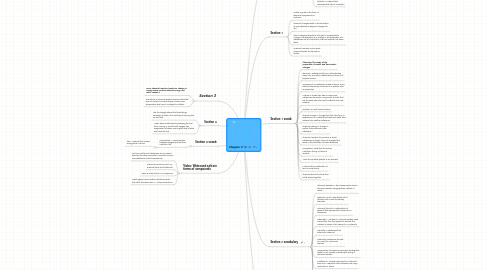Chapter 3
by Mike Kiecker


1. Section 3
1.1. every chemical reaction involves a change in energy some reaction absorbs energy and other realses it
1.2. The rate of a chemical reaction can be controlled by such factors ad concentration surface area temperature and use of a catalyst or inhibtor
2. Section 1
2.1. Matter may be in the form of elements compounds or mixtures.
2.2. chemical changes result in the formation of new substances physical changes do not
2.3. color changes prosecution of a gas or a precipitate a change in temperature or a change in the properties of a substances are all clues that a chemical reaction has taken place
2.4. Chemical reaction occurs when chemical bonds are formed or broken
3. Section 1 vocab
3.1. Chemistry:The study of the properties of matter and how matter changes
3.2. Element:A substance that can not be broken down into any other substances by chemical of physical means.
3.3. Compound: Is a substance made of two or more element chemically combined in a specific ratio, or porportion
3.4. Mixture: Is made from two or more pure substances elements, compounds, or both that are the same place but not combined as a new material.
3.5. Solution: Is a well mixed mixture
3.6. Physical change:A change that alters the form or appearance or a material but does not make thhe materiel into another substance
3.7. Chemical change:A change in matter that produces a new substance.
3.8. Chemical reaction:The process in which substances undergo chemical changes that result in the formation of new substances
3.9. Precipitate:A solid that forms form a solution during a chemical reaction
3.10. Atom:the smallest particle or an element
3.11. Molecule:the combination of two or more atoms
3.12. Chemical bond:The force that holds atoms together
4. Section 2 vocabulary
4.1. Chemical equation:A short easy way to show a chemical reaction using symbols instead of words
4.2. symbols:A one or two letters set of charters that is used to identify elements
4.3. Chemical formula:A combination of symbols that represent the element in a compunds
4.4. Subscripts: A number in a formula written lower and smaller than the symbol to indicate the number of atoms of an element in a molecule.
4.5. reactants:A substances that enters into chemical
4.6. Products:a substances formed as a result of a chemical reaction
4.7. Conservation of mass:The principle starting that matter is not created or destoryed during a chemical reaction
4.8. Coefficient:A number informant of a chemical formula in a equation that indicates how many molecules or atoms
4.9. Synthesis:A chemical reaction in which two or more simple substances combine to form a new more complex substance
4.10. Decomposition:A chemical reaction that brakes down compound into simpler products
4.11. Replacement reaction:A reaction in which one elements repales another in a compund or when two elements in diffrent compunds tradde places
5. Section 3 Vocabulary
5.1. Exothermic reaction:A reaction tht relases energy in the form of heat
5.2. Endothermic reaction:A reaction that absorbs energy in the form of ehat
5.3. Activation energy:The minimum amount of energy that has to be added to get a chemical reaction started
5.4. Concentration:The amount of one material in a certain volume of another material
5.5. Catalyst:A material that increases that rate of a chemical reaction by lowering the activation energy
5.6. enzyme:A biological catalyst that lowers the activation energy of reaction in cells
5.7. inhibitor:A material that decresses the rate of a reaction
6. Section 2
6.1. A chemical equation uses symbols to show the reactions and products of a chemical reaction
6.2. Matter is neither created nor destroyed during a chemical reaction
6.3. Chemical reaction may be classified by the types of changes in reactants and products
7. Section 4
7.1. The fire triangle shows the three things necessary to start a fire and keep it burning fuel air and heat
7.2. Water stops combustion by keeping the fuel from coming in contact with oxygen also evaporation of water uses a great deal of what and cools the fire
8. Section 4 vocab
8.1. Combustion: A rapid reaction between oxygen and fuel that rustults in fire
8.1.1. fuel:A material that relases energy when it burns
